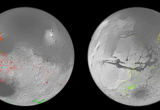A new map of aqueous alteration on Mars
Using the orbital imaging spectroscopy instruments OMEGA (Mars Express) and CRISM (MRO), the Solar System team has released the first global and high resolution map of hydrated minerals on Mars. These minerals hold the distinction of having been formed through interaction between the ancient Martian crust and liquid water, while many of them still contain some amount of water trapped within their structure. Such hydrated minerals are excellent tracers of past water-bearing environments and are a primary target of exobiology missions to Mars.
This global mineral map, which has been 10 years in the making, reveals that Mars exhibits today hundreds of thousands of hydrated mineral deposits, compared to some thousands known previously. More importantly, it reveals that early in its history (over 3.7 Gyr ago), Mars experienced aqueous alteration at a global scale, more so than was previously thought. Many identified mineral sites are the focus of further study for their high science potential, such as Oxia Planum, the proposed landing site for the Exomars rover, which was discovered through this study. The global mineral view will also help better understand the context of current or upcoming exploration sites.
On Earth, certain hydrated minerals such as clays (phyllosilicates) or salts (sulfates) are known for their potential to sequester and preserve organic matter, especially in sedimentary contexts. The identification on Mars of sites with similar composition and geology make them high priority science targets for the future exploration of organic matter on Mars.
In the long term, this mineral map will be used to better ascertain how much water is stored presently in Mars rocks and answer a critical question of Mars aqueous history: did the planet "soak up" its water into its rocks? Another objective is to identify potential candidate landing sites for the future human exploration of Mars. In addition to their intrinsic science value, hydrated minerals are a potential source of volatile (including water) resource, and could serve as construction material.
The mapping project is published in two papers, one studying the detailed distribution, the other the mineral abundances:
A Mars Orbital Catalog of Aqueous Alteration Signatures (MOCAAS) by J. Carter et al is in press in Icarus. 10.1016/j.icarus.2022.115164
The M3 project: 3 – Global abundance distribution of hydrated silicates at Mars by L. Riu et al is published in Icarus, Volume 374, 2022.
The data will be made available on the PSUP Planetary Surface portal
A new map of aqueous alteration on Mars





